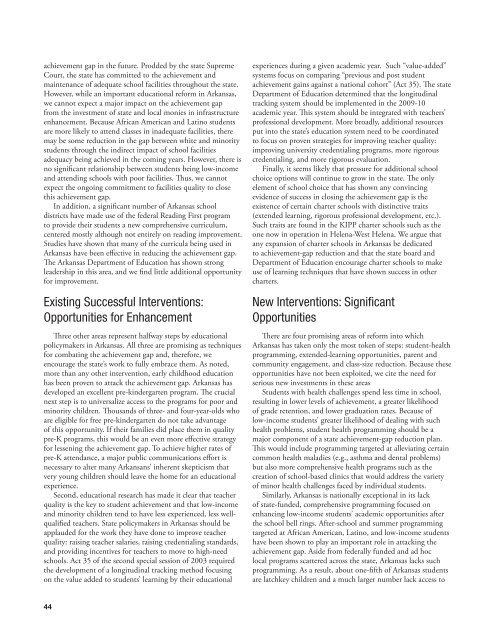WHAT IS ARKANSAS DOING TO CLOSE THE ACHIEVEMENT GAP?
WHAT IS ARKANSAS DOING TO CLOSE THE ACHIEVEMENT GAP?
WHAT IS ARKANSAS DOING TO CLOSE THE ACHIEVEMENT GAP?
You also want an ePaper? Increase the reach of your titles
YUMPU automatically turns print PDFs into web optimized ePapers that Google loves.
achievement gap in the future. Prodded by the state Supreme<br />
Court, the state has committed to the achievement and<br />
maintenance of adequate school facilities throughout the state.<br />
However, while an important educational reform in Arkansas,<br />
we cannot expect a major impact on the achievement gap<br />
from the investment of state and local monies in infrastructure<br />
enhancement. Because African American and Latino students<br />
are more likely to attend classes in inadequate facilities, there<br />
may be some reduction in the gap between white and minority<br />
students through the indirect impact of school facilities<br />
adequacy being achieved in the coming years. However, there is<br />
no significant relationship between students being low-income<br />
and attending schools with poor facilities. Thus, we cannot<br />
expect the ongoing commitment to facilities quality to close<br />
this achievement gap.<br />
In addition, a significant number of Arkansas school<br />
districts have made use of the federal Reading First program<br />
to provide their students a new comprehensive curriculum,<br />
centered mostly although not entirely on reading improvement.<br />
Studies have shown that many of the curricula being used in<br />
Arkansas have been effective in reducing the achievement gap.<br />
The Arkansas Department of Education has shown strong<br />
leadership in this area, and we find little additional opportunity<br />
for improvement.<br />
Existing Successful Interventions:<br />
Opportunities for Enhancement<br />
Three other areas represent halfway steps by educational<br />
policymakers in Arkansas. All three are promising as techniques<br />
for combating the achievement gap and, therefore, we<br />
encourage the state’s work to fully embrace them. As noted,<br />
more than any other intervention, early childhood education<br />
has been proven to attack the achievement gap. Arkansas has<br />
developed an excellent pre-kindergarten program. The crucial<br />
next step is to universalize access to the programs for poor and<br />
minority children. Thousands of three- and four-year-olds who<br />
are eligible for free pre-kindergarten do not take advantage<br />
of this opportunity. If their families did place them in quality<br />
pre-K programs, this would be an even more effective strategy<br />
for lessening the achievement gap. To achieve higher rates of<br />
pre-K attendance, a major public communications effort is<br />
necessary to alter many Arkansans’ inherent skepticism that<br />
very young children should leave the home for an educational<br />
experience.<br />
Second, educational research has made it clear that teacher<br />
quality is the key to student achievement and that low-income<br />
and minority children tend to have less experienced, less wellqualified<br />
teachers. State policymakers in Arkansas should be<br />
applauded for the work they have done to improve teacher<br />
quality: raising teacher salaries, raising credentialing standards,<br />
and providing incentives for teachers to move to high-need<br />
schools. Act 35 of the second special session of 2003 required<br />
the development of a longitudinal tracking method focusing<br />
on the value added to students’ learning by their educational<br />
experiences during a given academic year. Such “value-added”<br />
systems focus on comparing “previous and post student<br />
achievement gains against a national cohort” (Act 35). The state<br />
Department of Education determined that the longitudinal<br />
tracking system should be implemented in the 2009-10<br />
academic year. This system should be integrated with teachers’<br />
professional development. More broadly, additional resources<br />
put into the state’s education system need to be coordinated<br />
to focus on proven strategies for improving teacher quality:<br />
improving university credentialing programs, more rigorous<br />
credentialing, and more rigorous evaluation.<br />
Finally, it seems likely that pressure for additional school<br />
choice options will continue to grow in the state. The only<br />
element of school choice that has shown any convincing<br />
evidence of success in closing the achievement gap is the<br />
existence of certain charter schools with distinctive traits<br />
(extended learning, rigorous professional development, etc.).<br />
Such traits are found in the KIPP charter schools such as the<br />
one now in operation in Helena-West Helena. We argue that<br />
any expansion of charter schools in Arkansas be dedicated<br />
to achievement-gap reduction and that the state board and<br />
Department of Education encourage charter schools to make<br />
use of learning techniques that have shown success in other<br />
charters.<br />
New Interventions: Signifi cant<br />
Opportunities<br />
There are four promising areas of reform into which<br />
Arkansas has taken only the most token of steps: student-health<br />
programming, extended-learning opportunities, parent and<br />
community engagement, and class-size reduction. Because these<br />
opportunities have not been exploited, we cite the need for<br />
serious new investments in these areas<br />
Students with health challenges spend less time in school,<br />
resulting in lower levels of achievement, a greater likelihood<br />
of grade retention, and lower graduation rates. Because of<br />
low-income students’ greater likelihood of dealing with such<br />
health problems, student health programming should be a<br />
major component of a state achievement-gap reduction plan.<br />
This would include programming targeted at alleviating certain<br />
common health maladies (e.g., asthma and dental problems)<br />
but also more comprehensive health programs such as the<br />
creation of school-based clinics that would address the variety<br />
of minor health challenges faced by individual students.<br />
Similarly, Arkansas is nationally exceptional in its lack<br />
of state-funded, comprehensive programming focused on<br />
enhancing low-income students’ academic opportunities after<br />
the school bell rings. After-school and summer programming<br />
targeted at African American, Latino, and low-income students<br />
have been shown to play an important role in attacking the<br />
achievement gap. Aside from federally funded and ad hoc<br />
local programs scattered across the state, Arkansas lacks such<br />
programming. As a result, about one-fifth of Arkansas students<br />
are latchkey children and a much larger number lack access to<br />
44






